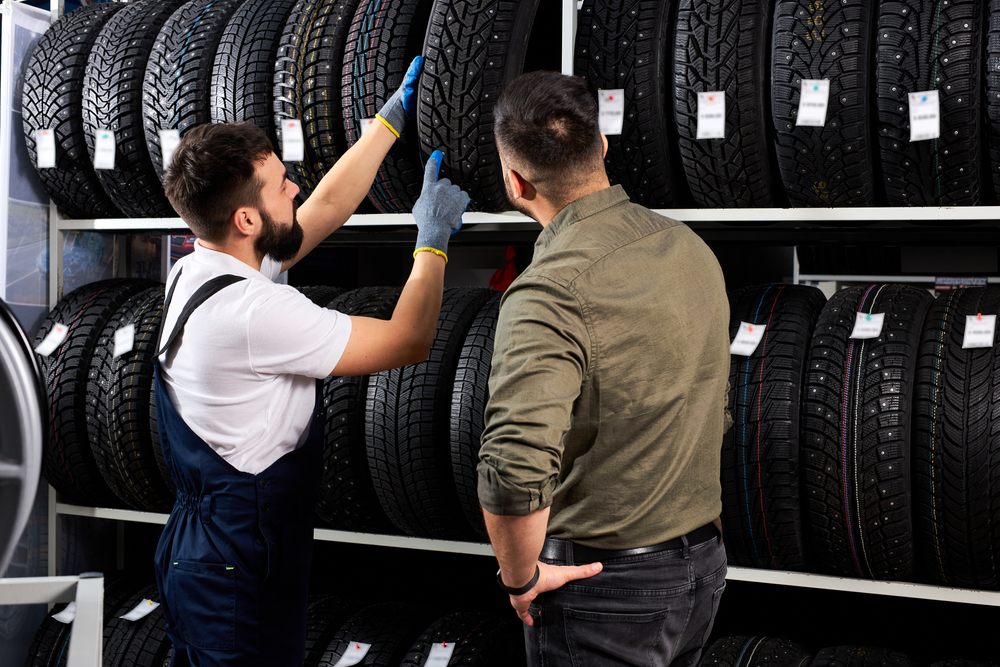
Many drivers pay extra for what they believe are premium tires, only to discover later that they have purchased a midrange product with a premium label. The tire world loves confident names and aggressive tread patterns, and sometimes that’s enough to fool anyone into thinking they’re getting the best. This matters because tires decide how your car brakes, grips, and stays planted in bad weather. When the rubber isn’t truly top tier, the car isn’t either. Understanding which models only look high-end can save you money and keep you safer.
This list highlights seven tires men often mistake for premium tires, yet each one falls short when pressure builds.
1. Goodyear Eagle Sport All-Season
The name sounds sporty, and the sidewall design helps the illusion. But the Eagle Sport All-Season performs more like an entry-level daily driver tire. Wet-road braking and tread life both trail the top of the pack.
Drivers pay more than they should because Goodyear’s performance reputation carries weight. In reality, the Eagle Sport feels inadequate during quick lane changes, and road noise builds faster than expected. For anyone chasing the feel of premium tires, this one doesn’t hold up.
2. Michelin Premier A/S
Michelin rarely disappoints, which is why many shoppers assume every Michelin model is a home run. The Premier A/S, though, is aging quickly. More recent tire designs outclass it in handling and wet traction, yet the price still sits near true premium tires.
The brand name buys goodwill, but the tread wears faster than drivers expect from a Michelin. It’s not unsafe or poorly made—it just no longer belongs in the premium tires conversation. You pay for a past reputation rather than present performance.
3. Pirelli P4 Four Seasons Plus
Pirelli is famous for exotic-car rubber, and that creates assumptions. The P4 Four Seasons Plus rides smoothly enough, but it can’t match the grip or steering response its name suggests. It’s tuned for longevity, not high-end control.
Many men buy it thinking they’re getting a scaled-down version of the P Zero. Instead, they get a mild-mannered commuter tire with average wet traction and slow cornering feel. Good for long tread life, not good if you expect premium tire behavior.
4. Firestone Firehawk AS
The Firehawk line carries a muscle-car vibe, and the tread pattern reinforces it. On paper, it looks like a tire built for spirited driving. On real pavement, it’s fine at daily speeds but loses precision when pushed.
The steering response feels mushy compared to the performance of real all-season options. Some drivers pick it thinking it’s a bargain version of a top-tier sport tire, but the gap shows up quickly on winding roads. Premium tires, this is not.
5. Toyo Extensa A/S II
Toyo makes some excellent tires, but the Extensa A/S II isn’t one of its headliners. Its low price is attractive, yet many shoppers assume that because Toyo builds strong performance models, this one carries some of that DNA. It doesn’t.
Cornering grip fades early, especially after the tread is half worn. Road feel is soft, and braking distances stretch compared to real premium tires. Many drivers only realize this after a season of spirited driving exposes its limits.
6. Falken Ziex ZE950
The Ziex line shows up on a lot of sedans and crossovers because it’s affordable and looks sporty. The ZE950 has a bold tread pattern that appears sophisticated, and that’s where the confusion starts. In practice, it struggles in wet emergency stops and loses grip faster than competitors.
The tire isn’t bad for the money, but that’s the point. It’s built for value, not the performance expectations attached to premium tires. Men who think they’re getting high-end handling usually end up disappointed after the honeymoon period fades.
7. Kumho Solus TA71
The Solus TA71 hides behind a clean design and a quiet ride, which can feel premium at first. Once you start demanding more grip—quick merges, sharp off-ramps, heavy braking—the weaknesses show. Grip fades early in the rain, and steering feedback is dull.
Most people buy it during a sale and assume they scored a premium tire at a discount. Instead, they get a comfort-first tire with performance limits that appear sooner than expected. Serious drivers move on quickly.
Why These Tires Keep Fooling People
Modern tire marketing leans heavily on tough names, sporty tread patterns, and brand recognition. That makes it easy to believe you’re buying premium tires when the model itself doesn’t support the claim. Most of the tires above aren’t bad—they’re simply not what many men assume they are.
If you want something that actually performs at the premium level, dig into independent tests or compare real braking distances. Even a quick glance at user feedback on a site like this tire review platform can clarify what you’re getting.
Have you ever bought a tire that looked high-end but fell short once mounted on the car?
What to Read Next…
- 9 Car Brands That Quietly Lost Consumer Trust In The Last 5 Years
- 7 Cars Most Men Won’t Buy Because They Don’t Look Manly Enough
- 8 Used Cars That Are Suddenly Skyrocketing In Value
- 8 Things You Should Never Keep In Your Car For Your Own Safety
- 9 Car Brands Losing Trust With Mechanics
The post 7 Tires Men Buy Thinking They’re Premium—But They’re Not appeared first on Clever Dude Personal Finance & Money.







